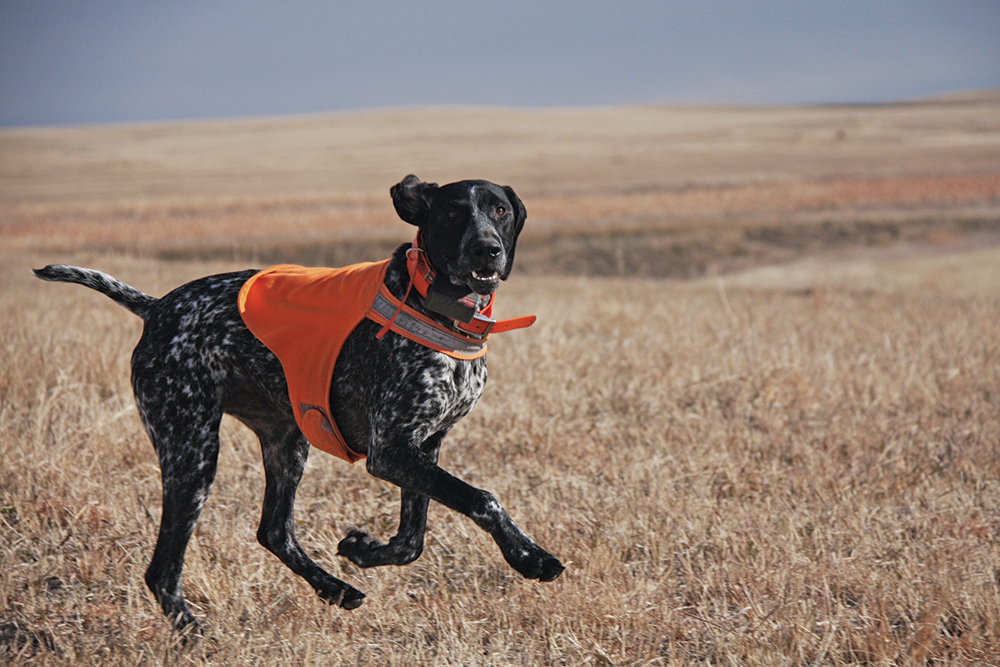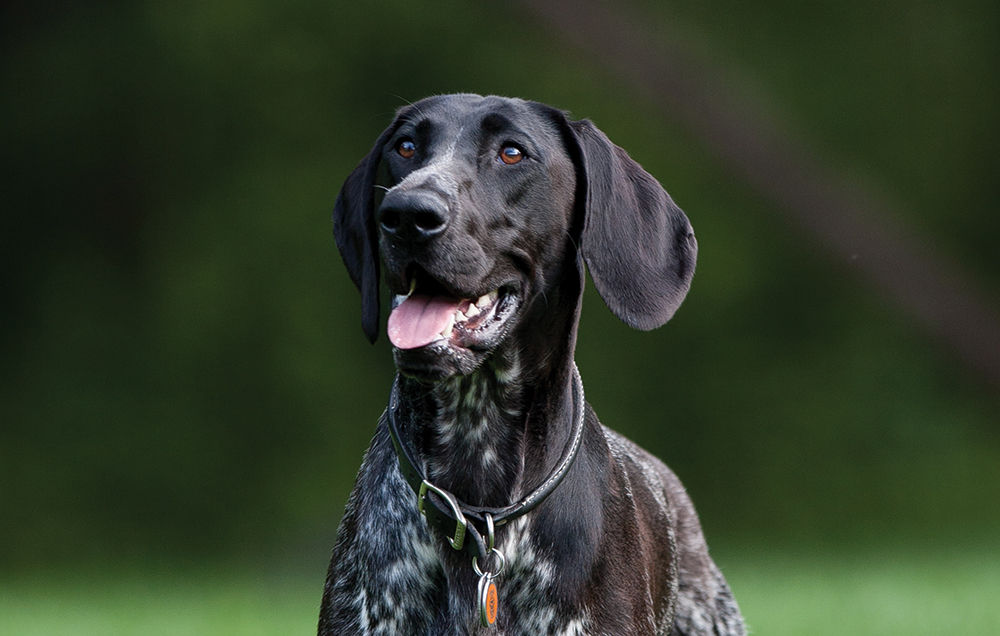Let Us Now Praise GSP’s

Picture this: You’re working the edge of a hay field turned brown, cut months before in late summer. A lanky young German shorthaired pointer plunges in and out of the thick brush bordering the field, working the cross wind. Without a moment’s pause, he dives again and again into the tangled mass of thorny raspberries, dried goldenrod, and buckthorn, quartering briefly out into the field for a gulp of chaff-free air between plunges. An older shorthair works the brush farther in from the edge, tracking bird scent along the single moist strip of ground bordering a rise of ledge.
Like the flick of a wrist, the young dog snaps on point, nose thrust into the snarl of vegetation, body and tail rigid. Your quick come-around whistle brings the veteran bird dog out into the field where he sees his bracemate and locks up sleek and sexy—head driven low and forward, body planed out parallel to the ground, front leg held up so tight the paw curls inward.
Deep breath—yours—while for the thousandth time you admire the shorthairs’ rippling muscles, their shiny coats, and their scent-driven intensity. Then you step in for the first woodcock flush of the season.
Dr. Edward D. Bailey, animal behaviorist and co-author of The Training and Care of the Versatile Hunting Dog, defines the versatile hunting dog has having four key characteristics: a balance of independence and dependence, the ability to control its emotions, a range of speeds that can be shifted as needed, and an extraordinary amount of cooperation with its hunter-handler. Add strength, elegance, endurance, athleticism, and sociability, and the definition is perfect for the German shorthaired pointer.

A Breed Apart
Shorthairs are the most popular breed in the North American Versatile Hunting Dog Association (NAVHDA) and arguably the most-popular versatile breed in the United States and Europe. They can be divided into three general types: field-trial lines, show-ring lines, and traditional hunting shorthairs. They were developed in the mid 1800s when the average hunter needed one dog that could do it all—find and point upland game, retrieve waterfowl, track furred game and running birds, and perform optimally on varied terrain in a range of temperatures. The early lines of the breed are believed to have been created primarily from Spanish pointers, with English pointers and setters mixed in among different German hounds.
Blaine and Patti Carter, owners of Merrymeeting Kennels in Brunswick, Maine, have been breeding traditional hunting shorthairs since 1984, producing generations of dogs capable of penetrating thick northern grouse woods one day, retrieving sea ducks off the coast the next, and holding steady on a covey of wild southern quail a week later.
“I started breeding German shorthairs to create a dog compatible with my type of hunting and needs—versatile, able to work in different temperatures, and having the social skills to live with the family,” Blaine explains. “Stability is a priority. I need a dog with a sound temperament both at home and during the hunt.”
Equally important was establishing a solid gene pool from which to expand their lines. “We want a dog with a disposition evenly capable of handling water and land. Strong water desire gives them the balance they need to be comfortable in the water, an environment that makes many dogs uneasy, undermining their ability to perform well,” says Blaine.

Common Characteristics
German shorthairs come in a variety of colors from all liver and all black to roan, brightly ticked, or predominantly white; some with large brown or black patches, some without. Their coats should be short and somewhat harsh. They are considered medium-size hunting dogs with a medium to wide range and medium to fast ground speeds.
All those “mediums” shouldn’t sound average or unexciting, however. “German shorthairs hunt with passion. They would never say quit,” says Carter.
The goal of Merrymeeting Kennels’ breeding program is to produce dogs that have functional conformation, are highly trainable, and have strong desire and instincts.
“Shorthairs are one of the most diverse of any hunting dog. They use their ability to air and ground scent to their advantage and are the most adaptable for the on-foot hunter,” Blaine adds.
My first Merrymeeting shorthair, Rimfire, has taught me more about versatility than I could have imagined. He’s convinced me to trust him when I want to turn north but he knows the birds are to the east and refuses to come to my whistle. He’ll wait patiently when I take a break to rest on a tree stump and contemplate the universe, and then will tear into the woods the second he gets the nod.
I’ve seen him track a ruffed grouse in the wrong direction—toward where it landed—and then stop, give me a look that says, “Gee, am I dumb!” (the canine equivalent of smacking yourself on the forehead with your palm), race back to where he started, and track the bird in the correct direction. He’s figured out how to pinch running pheasants and how to search for a downed bird in a pattern looping in and out of a central point like petals on a daisy.
Rimfire can lope wide across a Midwest prairie in search of sharptails or creep through an alder patch inhaling the wormy scent of a woodcock. On a last light duck hunt, he’ll sit remarkably still watching for mallards, ignoring other dogs, staring wistfully into the sky. And on point, he is nothing short of spectacular.

All those “mediums” shouldn’t sound average or unexciting, however. “German shorthairs hunt with passion. They would never say quit,” says Carter.
























